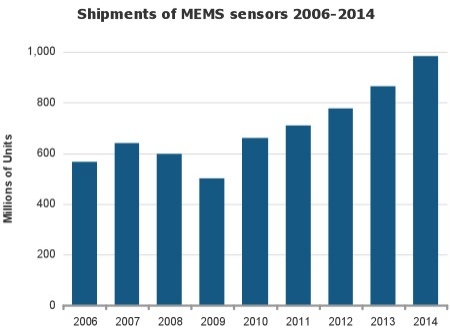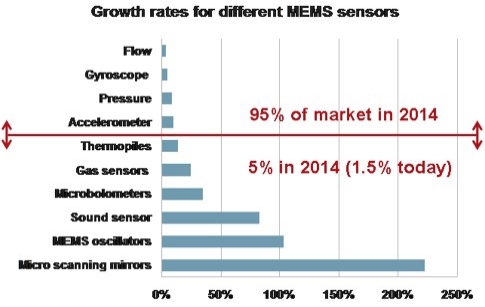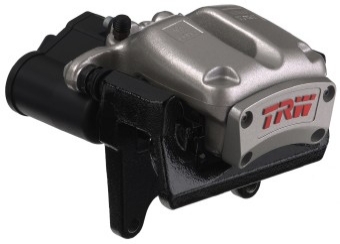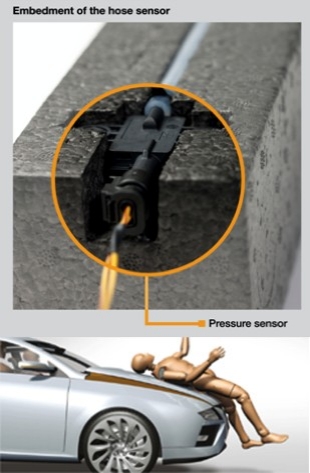by Richard Dixon, senior analyst for MEMS, iSuppli
December 22, 2010 – The year 2010 is shaping up to be a record year for automotive sensor production. As production levels have quickly returned to pre-crisis levels in the world’s major automotive regions, and China — even with current lower overall electronics content per car — continues its meteoric rise, the demand for automotive MEMS sensors is growing very strongly.
In fact, sensor production far outstrips what car consumption consumes, due to the replenishment of inventory pipelines that were depleted during the recession of 2009. By 2014, at least 984 million pressure sensors, accelerometers, gyroscopes, flow sensors, and other assorted MEMS devices will ship, which is up from the 501 million shipped in 2009 — a CAGR of more than 14% (Figure 1). In 2010, 662 million units will ship, exceeding the pre-crisis high point of 2007 of 640 million sensors.
In terms of revenue, the automotive MEMS market will top $2.1 billion in 2014, up from $1.4 billion in 2009, a CAGR of 9.4%.
 |
| Figure 1: The MEMS sensor market grew over 32% from 2009 to 2010. (Source: iSuppli) |
The supply chain recovers
The inventory supply chain was run close to dry in the first part of 2009, and the intervening period up to today has been spent returning levels to the historically normal inventory-to-sales’ ratios. However, the passenger car market has rebounded much faster than anyone thought possible — more strongly than some other segments of the global economy, and the high sensor sales in 2010 reflect robust car sales in 2010, regaining the lost ground in 2009. The high level of orders seen today is therefore a combination of the recovery in car production and this refilling of the pipeline. It will result in a lower sensor growth in 2011 and 2012, returning to normal growth levels around 2013 to 2014.
Big shapers: Safety mandates and China
One of the most significant drivers for sensors in passenger cars is mandated safety technologies such as electronic stability control (ESC) and tire pressure monitoring systems (TPMS). Adoption of new mandates relating to ESC and TPMS in South Korea, and similar measures expected shortly in Japan, will accelerate adoption rates worldwide. Both the US and Europe have adopted legislation on these systems, and other countries including Canada and Australia have quickly followed suit. The extra opportunity for suppliers to Japan and Korea for ESC and TPMS as a result together makes up more than $120 million just in this region in the next five years.
Meanwhile, China’s production continues to grow rapidly, and is the largest single region for cars. iSuppli data shows that Chinese vehicles have an overall electronics content of 10%-12% of the total vehicle value vs. 18%-20% in Europe or North America. Clearly China is playing catch-up, but the large volume of vehicles with relatively low equipment leaves lots of potential — for this reason, the Chinese market is extremely interesting and of enormous import to suppliers.
New applications and sensor consolidation
What kinds of devices are benefiting? The vast majority (95%) of the market for MEMS automotive sensors is made up by pressure, accelerometers, gyroscopes, and flow sensors. These four categories of device offer five-year growth rates raging from 6%-10%. The driver for increased deployment of these devices comes from emission regulations (mainly for pressure and flow sensors in engine management) and from mandated safety applications for inertial sensors, including airbags, electronic stability control systems, and tire pressure monitoring.
 |
| Figure 2: The big four sensors include gyroscope, pressure and accelerometers, categories that are partly driven by safety mandate and emissions regulations. A small but increasing portion of the market will involve more exotic MEMS devices. (Source: iSuppli) |
However, though a much smaller portion of the overall revenues (today 1.5%, but growing to 5% in 2014), emerging applications offer much higher growth rates and are interesting for companies trying to enter the automotive market. This category of devices includes gas sensors and infrared thermopiles to control air quality and temperature in the cabin, micro-valves for low-power consumption HVAC (beginning in 2012 from Microstaq), microbolometers for night vision, and oscillators for rear-view cameras.
Sensor consolidation is playing an important role. Sales of accelerometers employed to measure inclination for electronic parking brakes (EPB), whose adoption in Europe will accelerate in the next five years, is damped by ESC. Such systems are proliferating and in most cases already contain the 2-axis accelerometers capable of delivering the required inclination signal for EPB. For example, in TRW’s EPB system this function is integrated into the ESC ECU to save space, sharing the longitudinal acceleration signals over the can bus. This is a bane for sensor suppliers, which must seek out opportunities that involve standalone systems to provide additional sensors.
On the other hand, inclination-based car alarms do not access accelerometer signals in ESC systems, and require standalone accelerometers. Companies like Analog Devices and STMicroelectronics supply 2-axis or 3-axis accelerometers for this application.
Other examples of recent applications that do propagate sensors include passenger protection systems that detect impacts using either accelerometers or pressure sensors located in the front bumper. Stop-start systems, which are designed to lower emissions but turning the motor off when stopped at junctions, also continue to be an opportunity for pressure sensors that supply critical data when the engine is off.
 |
| Figure 3: Many electronic parking brakes rely on sensor fusion by accessing existing ESC accelerometer signals — a boon for the integrator but not necessarily for the sensor supplier. (Courtesy TRW) |
Supply chain rumblings
At long last, consumer-oriented sensor suppliers are finally making inroads into the automotive market. STMicroelectronics has so far targeted non-safety critical applications like car alarms and navigation, and also has now entered the airbag market with a high-g accelerometer. ST leverages significant manufacturing economies-of-scale, which will lead to additional price pressures and new cost structures in the industry.
 |
| Figure 4: Pressure sensors located in the front bumper impact absorption filling detect impact with a pedestrian and activate safety systems. (Source: Continental) |
Information in this article is based on a recently released iSuppli market tracker Automotive MEMS H2 2010.
Richard Dixon received his doctorate in semiconductor characterization from Surrey University and degree in materials science from North Kent University, and is senior analyst for MEMS at iSuppli, Spiegelstr. 2, 81241 Munich Germany; ph +49-89-207-026-070, e-mail [email protected].

